#13th century BCE
Text
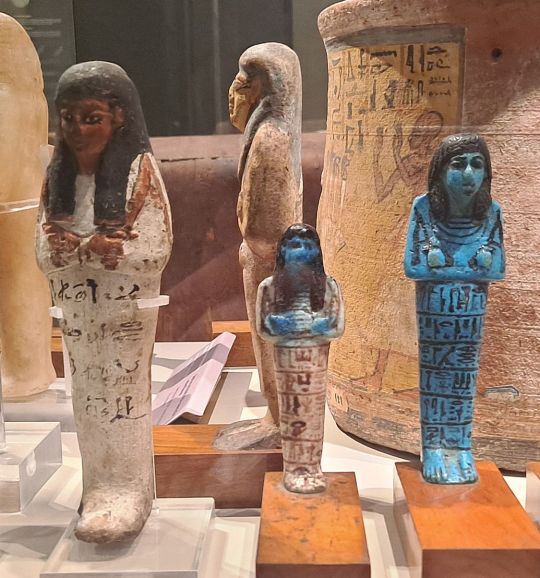
Funerary figurines
* Shabti of Paankh with inscription on cursive script. Bakerd clay, New Kingdom, 19th dynasty (1292-1190 BCE)
* Two shabtis of Userhat, scribe of Amon. Faience, New Kingdom, 19th-20th dynasty (1292-1076 BCE)
* Turin Egyptian Museum
Turin, June 2023
#Egypt#figurine#ancient#funerary#art#faience#ancient colours#13th century BCE#12th century BCE#11th century BCE#Turin Egyptian Museum#my photo
82 notes
·
View notes
Text
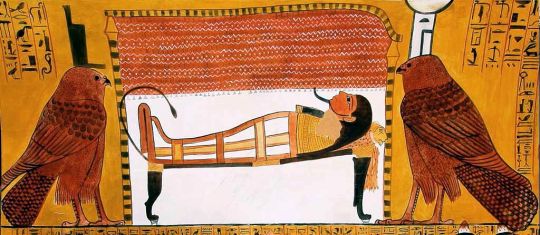
Isis, left, and Nephthys, right, as kites with the mummy of Sennedjem (19th dynasty of Egypt, 13th century BC).
They were often depicted as a kite or a person with wings, usually outstretched as a symbol of protection. The piercing, mournful cries of the kite seem to have reminded the ancients of the lamentations for the dead by wailing women (source).
In my view, the two kites look slightly different, which may indicate that Isis is depicted as a red kite and Nephthys as a black kite, but I'm just speculating here. The birds sound a little different too.
youtube
youtube
Isis's throne hieroglyph is commonly known.
So, let's look at Nephthys hieroglyphs. They were a combination of signs for:
basket (meaning lord or lady nb or nbt - depending on m or f)
+
flat loaf (meaning bread or an indication of feminine, alphabetic-t)
+
building, temple or enclosure (ḥwt)
Leading us to nbt-hwt.
Some therefore, translate her name into "Lady of the Enclosure".
(More info: Gardiner list: nbt-hwt, V30, X1, 07)
#leo#lammas#lamentations#sacrifice#ancient egypt#kite#prey bird#13th century BCE#northern bronze age
1 note
·
View note
Text

this was when internet memes began
#image#this is the#alaksandu treaty#from 13th century bce#which mentions hittite wilusa#bronze age anatolia at peak power babey#there r hittite records from around then that mention conflicts over the city#which mention achaean intercessors#slay
26 notes
·
View notes
Text
when homer calls women 'fair-cheeked' (καλλιπάρηος)--

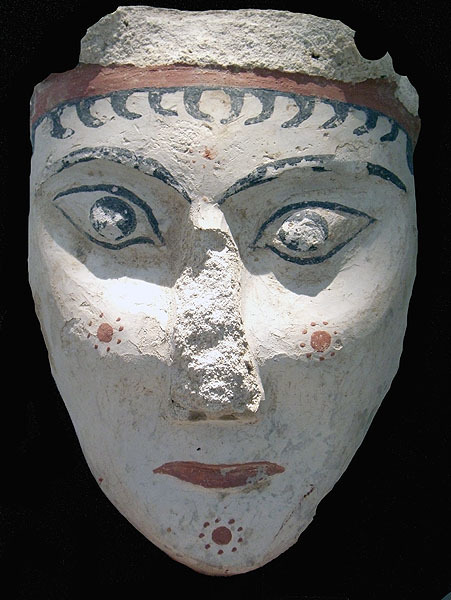
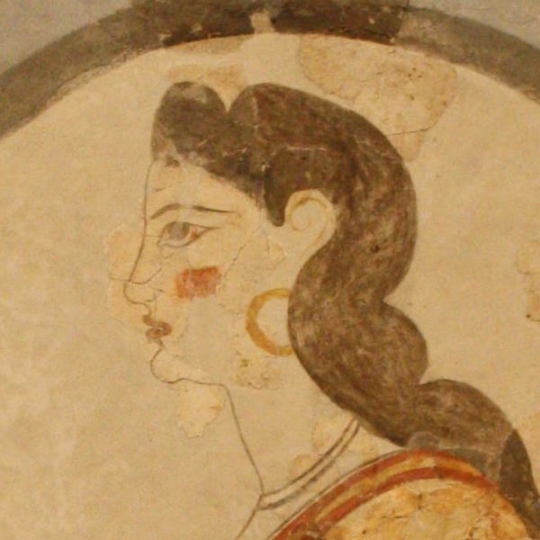
is it makeup?
#left and right are akrotiri house of the ladies#center is the 'sphinx head' from mycenae c. 13th century bce#iliadblogging#mine
48 notes
·
View notes
Text

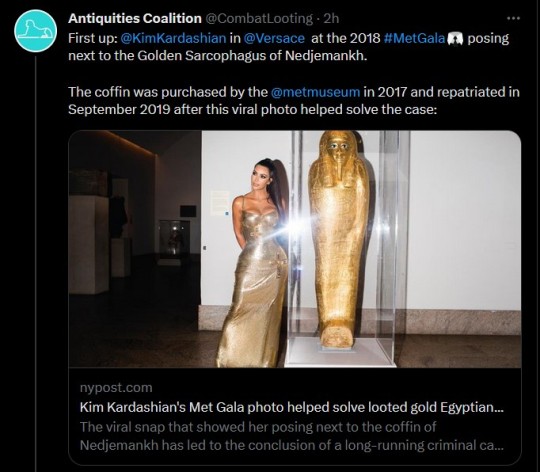
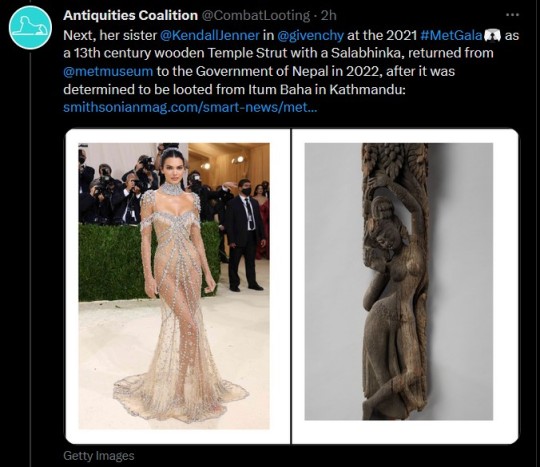
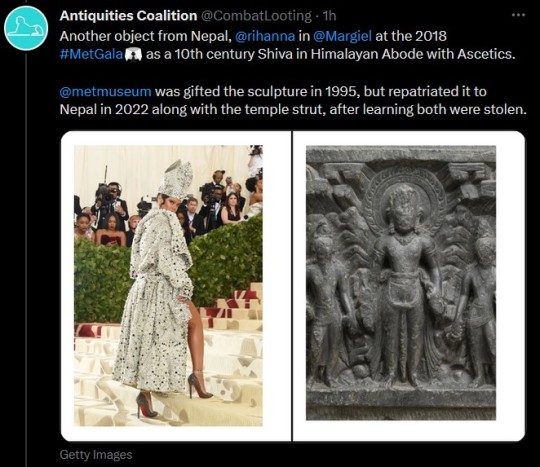

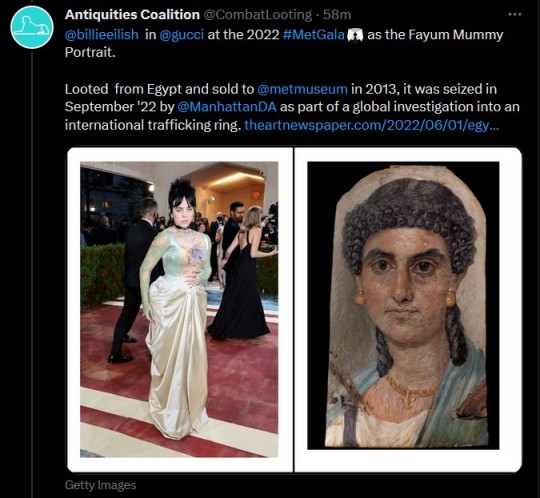
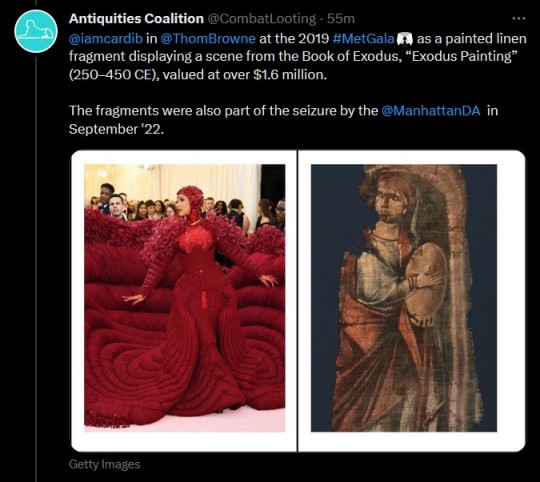
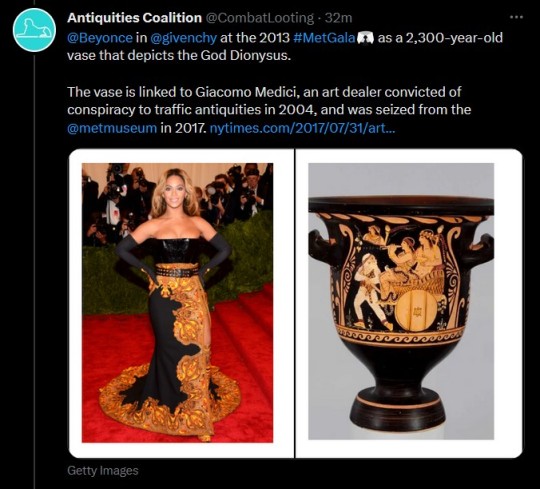
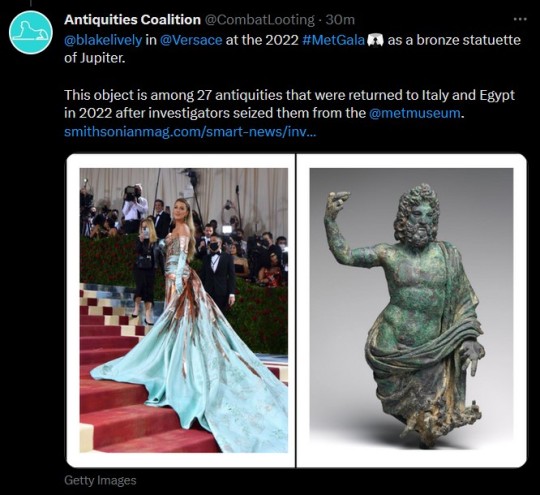
Looks vs. Loot at the Metropolitan Museum of Art by The Antiquities Coalition (@/CombatLooting) on Twitter
Transcription below the cut
1: The #MetGala may be "fashion's biggest night," but tonight's event hides some dark truths at @/metmuseum...including a long history of looted antiquities. To spotlight some of the contested objects from the Met's collection, we are featuring #MetGala vs. Loot [THREAD]
2. First up: @/KimKardashian in @/Versace at the 2018 #MetGala posing next to the Golden Sarcophagus of Nedjemankh. The coffin was purchased by @/metmuseum in 2017 and repatriated in 2019 after this viral photo helped solve the case. (link)
3. Next, her sister @/KendallJenner in @/givenchy at the 2021 #MetGala as the 13th century wooden Temple Strut with Salabhinka, returned from @/metmuseum to the Government of Nepal in 2022, after it was determined to be looked from Itum Baha in Kathmandu. (link)
4. Another object from Nepal, @/rihanna in @/Margiel at the 2018 #MetGala as a 10th century Shiva in Himalayan Adobe with Ascetics. @/metmuseum was gifted the sculpture in 1995, but repatriated it to Nepal in 2022 along with the temple strut, after learning both were stolen.
5. Dakota Johnson in @/gucci at the 2022 #MetGala as a terracotta kylix (c. 470 bCE). This piece, valued at $1.5 million, was seized from the @/metmuseum in July 2022 after being linked to Italian antiquities trafficker Gianfranco Becchina. (link)
6. @/billieeilish in @/gucci at the 2022 #MetGala as the Fayum Mummy Portrait. Looted from Egypt and sold to @/metmuseum in 2013, it was seized in September '22 by @/ManhattanDA as part of a global investigation into an international trafficking ring. (link)
7. @/iamcardib in @/ThomeBrowne at the 2019 #MetGala as a painted linen fragment displaying a scene from the Book of Exodus, 'Exodus Painting" (250-450 CE), valued at over $1.6 million. The fragments were also part of the seizure by the @/ManhattanDA in September '22.
8. @/Beyonce in @/givenchy at the 2013 #MetGala as a 2,300-year-old vase that depicts the god Dionysus. The vase is linked to Giacomo Medici, an art dealer convicted of conspiracy to traffic antiquities in 2004, and was seized from the @/metmuseum in 2017. (link)
9. @/blakelively in @/Versace at the 2022 #MetGala as a bronze statuette of Jupiter. This object is among 27 antiquities that were returned to Italy and Egypt in 2022 after investigators seized them from the @/metmuseum. (link)
5K notes
·
View notes
Text

Lotus Chalice
Egyptian, 13th-11th century BCE (New Kingdom-Third Intermediate Period)
Lotus chalices such as this one were probably used in both rituals and daily life. The vessel's shape imitates the blue lotus flower, which was a type of water lily.
164 notes
·
View notes
Text
PSA - Don't Treat JTTW As Modern Fiction
This is a public service announcement reminding JTTW fans to not treat the work as modern fiction. The novel was not the product of a singular author; instead, it's the culmination of a centuries-old story cycle informed by history, folklore, and religious mythology. It's important to remember this when discussing events from the standard 1592 narrative.
Case in point is the battle between Sun Wukong and Erlang. A friend of a friend claims with all their heart that the Monkey King would win in a one-on-one battle. They cite the fact that Erlang requires help from other Buddho-Daoist deities to finish the job. But this ignores the religious history underlying the conflict. I explained the following to my acquaintance:
I hate to break it to you [name of person], but Erlang would win a million times out of a million. This is tied to religious mythology. Erlang was originally a hunting deity in Sichuan during the Han (202 BCE-220 CE), but after receiving royal patronage during the Later Shu (934-965) and Song (960-1279), his cult grew to absorb the mythos of other divine heroes. This included the story of Yang Youji, an ape-sniping archer, leading to Erlang's association with quelling primate demons. See here for a broader discussion.
This is exemplified by a 13th-century album leaf painting. The deity (right) oversees spirit-soldiers binding and threatening an ape demon (left).

Erlang was connected to the JTTW story cycle at some point, leading to a late-Yuan or early-Ming zaju play called The God Erlang Captures the Great Sage Equaling Heaven (二郎神鎖齊天大聖). In addition, The Precious Scroll of Erlang (二郎寳卷, 1562), a holy text that predates the 1592 JTTW by decades, states that the deity defeats Monkey and tosses him under Tai Mountain.
So it doesn't matter how equal their battle starts off in JTTW, or that other deities join the fray, Erlang ultimately wins because that is what history and religion expects him to do.
And as I previously mentioned, Erlang has royal patronage. This means he was considered an established god in dynastic China. Sun Wukong, on the other hand, never received this badge of legitimacy. This was no doubt because he's famous for rebelling against the Jade Emperor, the highest authority. No human monarch in their right mind would publicly support that. Therefore, you can look at the Erlang-Sun Wukong confrontation as an established deity submitting a demon.
I'm sad to say that my acquaintance immediately ignored everything I said and continued debating the subject based on the standard narrative. That's when I left the conversation. It's clear that they don't respect the novel; it's nothing more than fodder for battleboarding.
I understand their mindset, though. I love Sun Wukong more than just about anyone. I too once believed that he was the toughest, the strongest, and the fastest. But learning more about the novel and its multifaceted influences has opened my eyes. I now have a deeper appreciation for Monkey and his character arc. Sure, he's a badass, but he's not an omnipotent deity in the story. There is a reason that the Buddha so easily defeats him.
In closing, please remember that JTTW did not develop in a vacuum. It may be widely viewed around the world as "fiction," but it's more of a cultural encyclopedia of history, folklore, and religious mythology. Realizing this and learning more about it ultimately helps explain why certain things happen in the tale.
#sun wukong#monkey king#journey to the west#jttw#Erlang#Erlang shen#Buddhism#Taoism#Chinese mythology#Chinese religion
331 notes
·
View notes
Text

Seated goddess with a child
Hittite
ca. 14th–13th century BCE
the met
106 notes
·
View notes
Text


El, Father of the Gods, and the King of Ugarit
Ugarit, Syria
13th century BCE
Top: Image from cover of "Stories from Ancient Canaan" by Michael David Coogan, 1978
Bottom: Ancient Near Eastern Pictures Relating to the Old Testament
James Pritchard, 1969
#el#ilu#elyon#el elyon#egypt#egyptian gods#canaan#canaanite gods#phoenicia#phoenician gods#aram#aramean gods#syria#syrian gods#levantine gods#mesopotamia#mesopotamian gods#pagan gods#polytheism#archeology#magic#witchcraft#witchblr#paganblr#occult#ugarit#ugaritic#ugaritic gods#ras shamra#king
233 notes
·
View notes
Text

(steddie | mature | 2.1k | cw: major character death (temporary, as in reincarnation) | tags: soulmates, starcrossed lovers, reincarnation | summary: In every life, in every universe, they will find each other again. What's a lifetime if you measure it in eternity? | @steddielovemonth prompt Love is a fire that never goes out | AO3)

1
Troy, 13th century BCE
Achilles often marveled at the serenity of the sea at night. His mother is tempestuous by nature, unpredictable and untamed, and most days the sea reflects her nature. But not tonight. Tonight the waves are shallow, a gentle rocking of their ships that had lulled Patroclus to sleep in his arms.
The lone candle on his bedside bathes the room in a warm orange glow, casting shadows across the naked skin of his lover. He can see his marks on the alabaster skin, pale as the moon to Achilles' sun-kissed skin.
Many people have said that they are a study in contradictions, one the perfect antithesis of the other. They're not entirely wrong, but they miss the point. The most important fact of all.
Patroclus is the other half of his soul, and they only make sense together.
The war rages on, and deep down Achilles knows he can't sit this one out forever. Everyone thinks he refuses to fight out of spite, a bruised ego and a prideful, stubborn nature, much like his mother's, that keeps him away from the front lines.
Sure, it feeds his ego to know they're losing without his sword, but it's not pride that keeps him from joining the Greeks in this senseless war.
It's fear.
He's not afraid for himself, never has been. Achilles is a hero, he's destined to die at the hands of another. It's a cold comfort, this knowledge of the path that awaits him: Glory, honor, death.
It's what will make him a god one day.
No one ever asked him if he wanted that. No one but Patroclus, half his soul, all his life. Being a god, worshipped and admired by the masses, pales in comparison to the feeling of dark brown eyes looking at him with nothing but love and devotion. They don't see a half god, Achilles knows that.
They see the lonely boy who only ever wanted someone to see him and love him for that. For what he is, not for what the prophecies say he will be.
Tomorrow he will take up his armor again. Not to win a war for a man blinded by pride and greed and stupidity.
For the man whose love burns as warm and bright as the fire on Mount Olympus, and only for him.
2
England, 15th century
Public executions are Stephanos' least favorite of his princely duties.
He hates to see men and women die by his father's hand, no matter who ties the knot or sets the stake on fire. It might as well be his father's hand swinging the axe. The only thing he hates more is the cheering of the crowd, the spectacle. How they enjoy the suffering, the death, being played out before them. They're probably glad it's not them, but that's no excuse in his eyes.
Stephanos vows that when he becomes king, he will be a more just ruler.
It hasn't always been this way with him. When he was a young boy, he wanted to be like his father. There had never been any question in his mind that the people who were executed for public entertainment deserved their fate. They had it coming, bad people needed to be punished.
Edmund showed him that wasn't true.
Disguised as a commoner, he had taken Stephanos out of the castle and into town. He had shown him how the people of the kingdom really lived, and who the villains really were: his father's men, who tormented and abused and exploited the people they were supposed to protect and serve.
Edmund, who had lost his parents to King Richard's cruelty and still retained his kindness and warmth, and who had shown Stephanos what true love really meant.
Love for his people, who deserved a king who would rule them justly and kindly.
Love for the friends he made along the way, as Edmund taught him about the suffering that was happening right under his nose.
Love for another man, a man who found it in himself to love the son of the murderer of his parents.
It's the only thing that keeps him upright when he's forced to watch his love burn at the stake for having bewitched the young prince. Witchcraft, the only acceptable explanation for what they had caught Stephanos and Edmund doing in Stephanos' chambers.
As the flames die down, long after the painful screams of the only man, the only person, Stephanos has ever loved, the fire within him burns brighter than ever. He vows to avenge his lover and honor his memory by being a ruler Edmund would be proud to call his king.
3
Normandy, 1944
"God, they tell you about the bullets and the bombs, the blood and the death, sure. But they never talk about the rain and the cold and the bloody mud, do they?" Stephen knows it's a rhetorical question because Edward loves to ask them.
"Ever wonder if our commanding officer has a map, or does he just like sending us on scenic tours of enemy territory?”
" Wonder if the rats in the trenches have formed a union yet. Bet they're negotiating better living conditions than we are.".
"Do you reckon the General's war strategy involves a magic eight ball? I mean, that would explain a lot."
At first it had pissed him off. It was bad enough that they had to fight alongside a British battalion with soldiers who talked funny and were trained in ways Stephen didn't really understand. Most of what they did didn't make sense to him and he just wanted them all to fuck off back to where they came from. Maybe take some Germans out on the way, because even in his irritation he could admit that they could use all the help they could get.
That didn't mean he had to like the hand attached to that help.
It's just that during the last two months they've been hunkered down somewhere in the north of France, with rain pouring down almost constantly, he's gone and fallen in love with an Englishman.
How embarrassing.
Even the accent kind of does it for him now, all thanks to Edward ("Would you just call me Eddie for Christ's sake, you literally saved my ass.") and his charming, if slightly odd, ways. He was infuriating, but kind and funny, always trying to cheer everyone up even when he was barely holding it together. Eddie made him laugh and blush and curse up a storm and roll his eyes fondly and cry exhausted tears into his surprisingly strong shoulders.
Eddie makes him feel alive. He makes Stephen want to be alive, too.
Most of all, he wants Eddie to be alive.
The gaping bullet wound in his chest tells Stephen that he may not get what he wants.
Eddie's hand in his is wet from the rain and too cold, as if the life has already begun to seep out of his limbs and with it all his warmth. Which is ridiculous, because no one burns as warm and bright as Eddie, even on the darkest days he would be their beacon of light. A roaring fire of life and love and hope.
A fire that couldn't be put out just like that. They needed him, all those young soldiers, barely 18, if that, who looked up to Eddie and worshipped the ground he walked on. Who would look out for them now? Who would keep their spirits up, their will to fight and live?
Stephen couldn't do it, not without Eddie.
"I can't do it without you, Eddie." He is not ashamed of the way his voice breaks as he holds the love he has just found in his arms, only to lose it again.
Eddie's eyes are warm and soft as they gaze into his, even with the pain clearly visible in them. "Yes, you can, sweetheart. They need you."
"I need you," Stephen sobs, his tears mixing with the rain that falls on a face he knows will one day be a fading memory. The thought hurts. It fucking hurts.
With the last of his strength, Eddie squeezes his hand. "You have me, Stevie. You'll always have me. My love will keep you warm long after my body has grown cold, I promise. I'll always be with you, in every life to come."
4
Hawkins, 1987
"Hey Eddie, it's me. Steve." Rubbing his hands over his face, Steve sighs, a sound as tired as he feels. "God, this is so stupid. You barely knew me. I barely knew you. I shouldn't be sitting here mourning you like we were anything more than two strangers thrown together in this fucking mess. Not that you don't deserve to be mourned, man. It makes me so fucking angry how they still refuse to see who you really were. A hero. A friend."
It's cold where Steve sits on the ground in front of a slab of stone that reads "Edward Munson".
"It's just... I don't understand why it hurts so much. It feels like, fuck, like there's a fist in my chest, in my stomach, squeezing so hard I can barely breathe some days. We all miss you. Not just the kids, although it hit Dustin the hardest. He's not the same and I don't know how to help him. Christ, I can't even help myself. I sleep with your vest under my bed, right next to my bat, how crazy is that? Most nights I can only sleep for a few hours if I touch it."
He runs his hand through his hair and grips it tightly, as if the pain helps make sense of everything he's feeling.
"You'd probably call me crazy, a fucking nutcase. Or maybe not. I don't know you well enough to say for sure, but I feel like maybe you wouldn't judge me too harshly. What I'm trying to say is this: I feel like when you died I lost something I didn't even know I had. Like, ugh, I dunno, I'm not good at this, you should have seen my college essay, Nancy told me it didn't make any sense. But it's like your death should be the period at the end of our story, right? The sentence is over, the story is told. Only it feels like it's just a semicolon and part of the story is still coming. That doesn't make sense, does it?"
Sighing again, this time because he's annoyed at himself for not finding the right words to explain himself, he climbs to his feet and slaps his hand on the cold stone.
"Right. Sorry for disturbing your rest. You deserve some rest, Eddie. Thank you for saving us. For saving Dustin. And for, y'know, saying those things in the woods. I never told you that, but it still means a lot to me."
The you still mean a lot to me swings in the space between the living and the dead, the thread that holds both worlds together.
5
Chicago, 2023
Steve knows they should go inside. They're too old to sleep out on the cold, hard ground, even if the night air is mild at this time of year. Steve and Eddie aren't 20 anymore, they're twice that age, and he knows they're going to regret not sleeping in a real bed in the morning.
"We should go inside, it's getting late," he says to Eddie, but his husband just hums where he's nestled into Steve's side, his cheek on Steve's chest. Right over his heart, where he's carved out his own space in the two decades they've been together.
"Just a little while longer, love. I don't want to miss it."
Eddie sounds wide awake, as excited to be lying in the garden outside their little house on the outskirts of town as he is about anything else in their lives. It's one of the most endearing things about him. Every day with him is a new adventure, even if it's Sunday morning reruns of Friends.
"Miss what, babe?"
"The shooting stars. Didn't you listen to Dustin when he said there was a meteor shower tonight?"
Steve chuckled. Of course his little brother would know such things. He has to admit that he didn't listen to his ramblings when he stopped by for lunch, too distracted by the way the autumn sun had cast shadows on Eddie's face. Not that he'd say it out loud.
"Mhhh. Must have slipped my mind. So, what do we wish for?" It comes out more earnest than he intended, his teasing feeling oddly displaced in the face of the pure love and adoration on Eddie's face as he leans up on his elbow to look down at Steve.
"For another lifetime with you. What more would I want than more of what we already have, preferably an eternity of it."
Out of the corner of his eye, Steve sees the first shooting star streaking across the night sky, and as he pulls Eddie down for a kiss, he wishes for just that.
#steddie#steddie fanfiction#stranger things fanfiction#steve harrington#eddie munson#cw: major character death#reincarnation#steddie soulmates#steddielovemonth#day 26#love is a fire that never goes out#my writing
59 notes
·
View notes
Text

Ramesses II
19th dynasty
Black granite
Museo Barrocco di scultura antica, Rome
Rome, July 2015
49 notes
·
View notes
Text
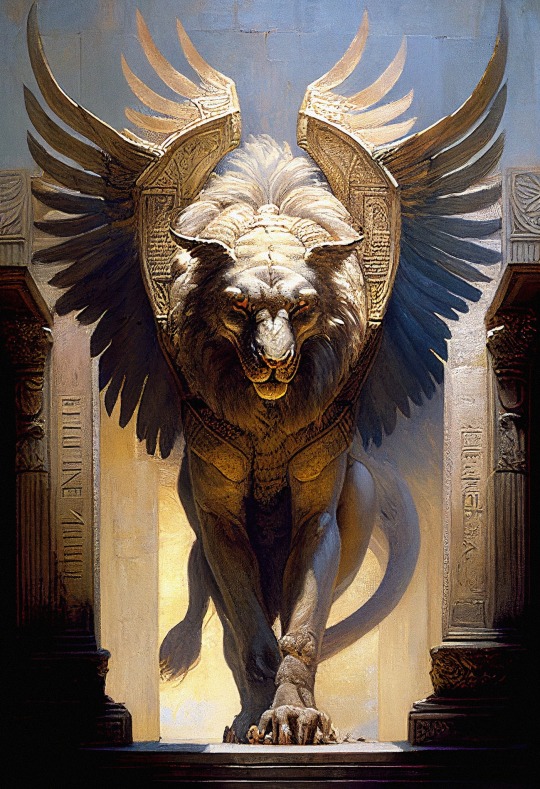
No beginning or end: it was a concept that best described the existence of Zurvan Akarana, an ancient Persian deity. He had no beginning, no end, or a specific gender (although he’s often referred to as a male) and could have been best symbolized as being “a circle of eternal life.”
Zurvan
Talon Abraxas
The earliest mentions of Zurvān appear in tablets dated to about the 13th and 12th centuries bce, found at the site of the ancient Mesopotamian city of Nuzi. Known also as the god of growth, maturity, and decay, Zurvān appeared under two aspects: Limitless Time and Time of Long Dominion. The latter emerges from Infinite Time, lasts for 12,000 years, and returns to it. Zurvān was originally associated with three other deities: Vayu (wind), Thvarshtar (space), and Ātar (fire).
Zurvān was the chief Persian deity before the advent of Zoroastrianism and was associated with the axis mundi, or the centre of the world. The most common image of Zurvān depicts a winged, lion-headed deity encircled by a serpent, representing the motion of the Sun.
38 notes
·
View notes
Note
Hi curious anon here. You mentioned in one of your posts (I think the sennek one? If I’m spelling it right) that the exodus from Egypt was metaphorical as the enslavement in Egypt didn’t happen, but I thought it did? Can you explain? (If you’re happy to of course)
Hi Anon! Thanks for your question. My response is looong lol (you got me going about a special interest), so buckle up!
Sooo I’m going to make a few guesses here, based on the way you’ve phrased your question. Judging from the fact that you’ve written Sukkot as “sennek” (I've looked through recent posts, and I think this is the post you're referring to), I’m going to guess that you’re not Jewish.
And judging from the fact that you think that Shemot, or “Names” (commonly written in Christian bibles as Exodus), is a literal historical account of Jewish history, I’m guessing that you have a Christian background.
You’re not alone in this. And I’m not saying this to pick on you. Many Christians have a literalist interpretation of the Bible, and most have zero knowledge of Jewish history (aside from maybe knowing some facts about the Holocaust). And so, what knowledge of Jewish history you have mostly comes from the Tanakh (what you call the Old Testament).
Tanakh is an acronym. It stands for Torah (the Five Books of Moses), Nevi’im (Prophets), Ketuvim (Writings). Also, the Tanakh and the “Old Testament” are not the same. The Tanakh has its own internal organization that makes sense for Jewish practice. The various Christian movements took the Tanakh, cut it up, reordered it, and then often mistranslated it as a way to justify the persecution of various groups of people — I’m looking at you, King James Bible.
But back to Shemot, the “Exodus” story. The story of Moshe leading the Israelites out of Egypt is more of a Canaanite cultural memory of the Late Bronze Age Collapse between around 1200 – 1150 BCE, which was preserved in oral history and passed down through the ages until it was written down in the form that we know it in the 6th century BCE by Jewish leaders from the Southern Kingdom of Judah.
Since the text is influenced by Babylonian culture and mythology, just as Bereshit is (which you know as Genesis), it is likely that some of the writing and editing of Shemot took place during and after the Babylonian exile in the 500s BCE.
Now, I’m guessing that what I’ve just written in these two paragraphs above sounds very strange to you.
Wait, you might say, didn’t the Israelites conquer the land of Canaan?
Wasn’t the "Exodus" written by Moses’s own hand during the 13th century BCE?
And wasn’t the Pharaoh in the Exodus Ramesses II (aka Ramesses the Great), who ruled in the 13th century BCE?
Actually, no. None of that happened.
The Israelites didn’t conquer Canaan. The Israelites were the same people as the Canaanites, and these are the same peoples as who later became the Jews, as I will explain. The Semitic peoples who would become the Jewish people have been in this area of the Levant since the Bronze Age.
Moshe was not a historical figure and did not write the Torah.
The “Pharaoh” in Exodus is not any specific Egyptian ruler (Ramesses the Great as the “Pharaoh” is mostly a pop culture theory from the 20th century).
Okay, now that I’ve said all that, let’s dive in.
The first ever mention of Israel was inscribed in the Merneptah Stele, somewhere between 1213 to 1203 BCE. Pharaoh Merneptah, who was the Pharaoh after Ramesses the Great, describes a campaign in Canaan to subdue a people called Israel. But there is no mention of plagues or an exodus because those things didn’t happen. The Canaanites were not slaves in Egypt. Canaan was a vassal state of Egypt.
In fact, the events that occurred during the reign of a later Pharaoh, Ramesses III, relate more to Jewish history. Ramesses III won a pyrrhic victory over the Peleset and other “Sea Peoples” who came to Egypt fighting for resources during a time of famine, earthquakes, and extreme societal turmoil. And Ramesses III would witness the beginning of the end of the Bronze Age.
The Canaanites, who were a Semitic people in the Levant, gradually evolved into the people who would become the Northern Kingdom of Israel and the Southern Kingdom of Judah (i.e., Jewish people), but during the 13th Century BCE, they were Canaanites, not Jews.
The Canaanites were polytheistic, worshiping a complex pantheon of gods; they didn’t follow the later Jewish dietary laws (i.e., they ate pork); and their religious practice bore little to no resemblance to the Jewish people of the Second Temple Period.
So, to reiterate, the people in Canaan who called themselves Israel during the Bronze Age were a Semitic people, but they were not recognizably Jewish, at least not to us Jews today. Canaan was a vassal state of Egypt, just as Ugarit and the Hittite Empire were.
Canaan was part of the vast trading alliance that allowed the Bronze Age to produce the metal that historians have named it for: bronze.
Bronze is a mixture of copper and tin (about 90% copper and 10% tin), and in order to make it, the kingdoms of the Bronze Age had to coordinate the mining, transportation, and smelting of these metals from all over the known world. This trading network allowed for the exchange of all sorts of goods, from grain to textiles to gold. Canaan was just one of these trading partners.
Well, between 1200 BCE and 1150 BCE, this entire trading alliance that allowed Bronze Age society to function went (pardon the expression) completely tits up. This is likely due to a large array of events, including famine and earthquakes, which led to an overall societal disarray.
Some of the people who were hardest hit by the famine, people from Sardinia and Sicily to Mycenae and Crete, came together in a loose organization of peoples, looking for greener pastures. These were all peoples who were known to Egypt, and many of them had either served Egypt directly or had traded with Egypt during better days. According to ancient records, this loose grouping of peoples would arrive at various cities, consume resources there, and then leave for the next city (sacking the city in the process).
Just to be clear, these people were just as much the victims of famine as the cities they sacked. There were no “good guys” or “bad guys” in this equation, just people trying as best as they could to survive in a world that was going to shit.
Well, these “Sea Peoples” (as they were much later dubbed in the 19th century CE) eventually made their way to Egypt, but Ramesses III defeated them in battle around 1175 BCE. He had the battle immortalized on his mortuary temple at Medinet Habu.
We don’t know much about these Sea Peoples, but we do know what the Egyptians called them. And from those names, we can figure out some of their origins. Peoples such as the Ekwesh and the Denyen. These were likely the Achaeans and the Danaans.
If you’re familiar with Homer’s Iliad, you’ll recognize these as some of the names that Homer gives to the Greek tribes. Many of the Sea Peoples were from city states that are now part of Greece and Italy.
Yes, the Late Bronze Age Collapse of the 12th Century BCE didn’t just get handed down as a cultural memory of the “Exodus” to the people who would centuries later become the Jews. That cataclysm also inspired the stories that “Homer” would later canonize as the Trojan War in the Iliad and the Odyssey. The Exodus and the Trojan War are both ancient cultural memories of the same societal collapse.
And neither the Trojan War nor the Exodus are factual. However, despite having little to no historicity, they both capture a similar feeling of the world being turned upside down.
Well, back to the Sea Peoples. Remember the Peleset that I mentioned a few paragraphs ago? They were one of these “Sea Peoples” that Ramesses III defeated. They were likely Mycenaean in origin, and possibly originated from Crete. After Ramesses III defeated them, he needed a place to relocate them along with several other tribes, including the Denyen and Tjeker. It was a “you don’t have to go home, but you can’t stay here” situation.
So, Egypt rounded up the surviving Peleset and sent them north to settle — to the land of Canaan.
Now, if you have some Biblical background, let me ask you this. What does “Peleset” sound like? What if we start it with an aspirated consonant, more of a “Ph” instead of a “P”?
That’s right. The Peleset settled in Canaan and became the Philistines.
This is where the real story of the people who would become the Jews begins.
As the Mycenaean (aka Greek) Peleset settled in their new home, they clashed with the Semitic Israelite people of Canaan. Some of these Canaanites fought back. These Canaanites also organized themselves into different groups, or “tribes.” (See where this is going?) Some of these tribes were in the Northern area of Canaan, and some were in the South, but there was a delineation between North and South — aka they did not start out as one people and then split in two. They started as two separate groups.
If you’re following me so far, you’ll know that I’m now talking about what would in time become the Northern Kingdom of Israel and the Southern Kingdom of Judah.
Well, backtracking a bit. The Bronze Age was ending, and the Iron Age was about to begin. The Peleset/Philistines were experts at smelting iron, which was harder to work with than bronze due to it having a much higher smelting temperature. When the Peleset settled in Canaan, they brought this iron smelting knowledge with them, and they used it to make weapons to subdue the local Canaanite peoples. The Canaanites therefore had to fight back “with sticks and stones.”
Hmm. Does that sound familiar? Who is one of the most famous Philistines you can think of from the Tanakh (the Old Testament)? I’ll give you a guess. It’s in the Book of Samuel (in the Tanakh, that’s in the Nevi’im — The Prophets).
That’s right. Goliath.
The story of “David and Goliath” is likely a Jewish cultural memory that was transmitted orally from the time of the Canaanite struggles against the Peleset.
The man who would become King David used a well-slinged stone to fell the much greater Goliath, and then he used Goliath’s own iron sword to cut off Goliath’s head.
In this metaphor, we can see the struggle between the Canaanite tribes and the Peleset, as the Canaanites fought to hold off the Peleset’s greater military might.
Historically, the Peleset eventually intermarried with the Canaanites, and within several generations, they were all one people. Likewise, the Mycenaean Denyen tribe may have settled in the Northern Kingdom of Israel, intermarried with the Canaanites, and become the Tribe of Dan.
The Book of Samuel, containing the story of David and Goliath, was written down in the form we would recognize today in the 500s BCE during the Babylonian Exile. It is a cultural memory of the time that the Canaanites were unable to wield iron weapons against a much more technologically advanced society, and it would have resonated with the Jews held captive in Babylon.
And with this mention of the Babylonian Exile, I come to the question that remains. And I think the question that you are asking. Where did the story of Shemot, the “Exodus,” the “Going Out,” come from?
And more importantly, why was that story so important to canonize in the Torah — the Jewish people’s “Instruction”?
The Shemot was likely written down and edited in a form that we would recognize today during and after the Babylonian Exile.
So, what was the Babylonian Exile? And what was its impact on Judaism?
To answer that, I need to start this part of the story about 130 years before the Babylonian Exile, in around 730 BCE. We’re now about 450 years after the Late Bronze Age Collapse, when the Canaanites were fighting the Peleset tribe.
Between about 730 and 720 BCE, the Neo-Assyrian Empire conquered the Northern Kingdom of Israel.
Now, you may know this as the time when the “Ten Tribes of Israel were lost.”
In reality, the Assyrians didn’t capture the entire population of Israel. They did capture the Israelite elite and force them to relocate to Mesopotamia, but there were many people from the Israelite tribes left behind. The Ten Tribes were never “lost” because many of the remaining people in the Northern Kingdom migrated south to the Kingdom of Judah.
One such group of people from the Northern Kingdom of Israel maintained their distinct identity and still exist today: the Samaritans. These are the people who today are the Samaritan Israelites. They have their own Torah and their own Temple on Mount Gerizim, where they continue the tradition of animal sacrifice, as the Jews did in Jerusalem before the Romans destroyed the Second Temple in 70 CE. The Samaritans keep the Sabbath, they observe Kashrut laws (i.e., they keep kosher), and they hold sacrifices on Yom Kippur and Pesach. In short, they have maintained religious practices that are similar to Judaism during the Second Temple period.
This mass migration into the Kingdom of Judah in the late 700s and early 600s BCE is where Judaism as we know it today really started to take shape.
At that time, the people of the Northern Kingdom of Israel were polytheistic. They ate pork. They did many of the things that the writers of the Torah tell the Jews not to do.
This is where many of these commandments began, when the priests of Judah needed to define what it was to be a Jew (a member of the Tribe of Judah), in the face of this mass migration from the Kingdom of Israel.
You see, the Ancient Jews didn’t know about germ theory or recognize that trichinosis was caused by eating undercooked pork. That’s not why pigs are treyf. Pigs are treyf because eating pork began as a societal taboo. In short, pigs take a lot of resources to care for, and they eat people food, not grass (i.e. they don’t chew a cud). So if you kept pigs, you would be taking away resources from other people. When you are living in a precarious society that is constantly being raided and conquered by outsiders, you have to make sure that your people are fed, and if you’re competing with a particular livestock over food, that livestock has to be outlawed.
This time period is also likely when the Kingdom of Judah started to practice monolatry (worshiping one God without explicitly denying the existence of other Gods). The people of Judah worshiped YHWH (Adonai) as their God, and the Northern Kingdom of Israel worshiped El as the head of their polytheistic pantheon. The Jews put both of them together as the same G-d. That is why the Bereshit (Genesis) begins:
When Elohim (G-d) began to shape heaven and earth, and the earth then was welter and waste, and darkness over Tehom (the Deep), and the breath of Elohim (G-d) hovering over the waters
NOTE: This is a modification to Robert Alter’s translation of the first two lines of Bereshit (Genesis) in the Tanakh. In a few paragraphs, I will explain the modification I’ve made of transliterating the Hebrew word “Tehom,” instead of (mis)translating this word as “the Deep” as in nearly every translation of Genesis.
Then over the next two hundred years, monolatry would gradually become monotheism. One of the Northern Kingdom’s gods, Baal, was especially popular, so the Judean leadership had to expressly forbid the worship of this god during the writing of the Tanakh.
The message was clear: If we’re going to be one people, we need to worship one G-d. And the importance of the Babylonian Exile cannot be overstated in this shift from monolatry to monotheism. The period during and after the Babylonian Exile is when most of the Tanakh was edited into a form that we would recognize today.
So, I come back to the question, what was the Babylonian Exile? It began, as many wars do, as a conflict over monetary tribute.
Around 598 BCE, the Judean King Jehoiakim refused to continue paying tribute to the Babylonian King Nebuchadnezzar II. And so in around 597 BCE, Nebuchadnezzar II’s troops besieged Jerusalem, killed King Jehoiakim, and captured much of the Judean leadership, holding them captive in Babylon. Over the next ten years, Nebuchadnezzar II continued his siege of Jerusalem, and in 587, he destroyed the First Temple, looted it for its treasures, and took more of the Jews captive. The deportation of the Jewish people to Babylon continued throughout the 580s BCE.
So, by the 570s BCE, the majority of the Jews were captives in a strange land. They were second-class citizens with few rights. The Jews feared that their people would start to assimilate into Babylonian society, intermarry so that they could secure greater freedom for their descendants, and then ultimately disappear as a unique people.
The Jewish leadership knew that this assimilation would begin by the Jews worshiping Babylonian gods.
So the Jewish leadership had a brilliant idea. They said, “We are not in danger of our people drifting into polytheism, assimilation, and cultural death, because we declare that the Babylonian gods do not exist. There is only one G-d, Adonai.”
Now we have left monolatry, and we are fully in monotheism.
And so, the Jews in captivity took Babylonian stories that their children heard around them, and they made these stories Jewish.
That is why the opening lines of Genesis sound so much like the opening lines of the Babylonian creation story, the Enuma Elish.
And remember when I mentioned that I had transliterated “Tehom” in the first two lines of Bereshit (Genesis) above, instead of using the standard translation of “the Deep”? That is because Tehom is a Hebrew cognate for the Babylonian sea goddess Tiamat, who the Babylonian god Marduk defeated and used to shape the heavens and the earth, just as Elohim shaped the heavens and the earth.
When you read the Enuma Elish, you can see the parallels to Genesis:
When the heavens above did not exist,
And earth beneath had not come into being —
There was Apsû, the first in order, their begetter,
And demiurge Tiamat, who gave birth to them all;
They had mingled their waters together
Before meadow-land had coalesced and reed-bed was to be found —
When not one of the gods had been formed
Or had come into being, when no destinies had been decreed,
The gods were created within them
That is also why the flood story of Noah and the Ark sounds so much like the flood story from the Epic of Gilgamesh.
That is why the story of Moshe’s mother saving him by placing him in a basket on the Nile River parallels the story of King Sargon of Akkad’s mother saving him by placing him in a basket on the Euphrates River.
In order to survive as a people, the Jews consolidated all gods into one G-d. Adonai. Shema Yisrael Adonai eloheinu Adonai ehad. "Hear O Israel, the Lord is our God, the Lord is One."
The Jews said, yes, we acknowledge that we are hearing these polytheistic Babylonian stories in our captivity, but we will make them our own so that we can continue to exist as a people.
But back to your question. What about the story told in Shemot, the “Exodus” from the Land of Egypt?
I think by now you can see the parallels between the Jewish people held as captives in Babylon and the story that they told, of the Israelites held as slaves in Egypt.
And so, the Exodus story, which had been told and retold in various ways as a means to process the cataclysmic trauma of the Late Bronze Age Collapse (similar to the oral retellings of the Trojan War epic before they were written down by “Homer”), now took on a new meaning.
The Exodus story now represented the Jewish people’s hope for escape from Babylon. It represented the Jewish people’s desire to rebuild the Temple in Jerusalem that Nebuchadnezzar II had destroyed. It represented the acceptance that it would take at least a generation before the Jews would be able to return to Jerusalem.
And it represented a cautionary tale about leaders who become too powerful, no matter how beloved they may be.
At a Torah study this Sukkot, the Rabbi discussed why the writers of Devarim (Deuteronomy) said that Moshe couldn’t enter Canaan, even though he'd led the Israelites out of Egypt (which, again, didn't literally happen). And one interpretation is because the Jewish leaders were writing and editing the Exodus during and shortly after the Babylonian Exile, and after seeing the Kingdom of Judah fall because of bad leadership. And they were saying, “It doesn't matter how beloved a leader is. If they start becoming a demagogue, and start behaving as someone who is drunk on their own power, you can't trust them as a leader. And you need to find new leadership.” And damn if that isn't a lesson that we could all stand to learn from!
So, was the Exodus story historically true? No. But does it matter that the Exodus story isn’t historically true? No, it does not. It was and is and will continue to be deeply meaningful to the Jewish people. The Shemot, the Exodus, the breaking of chains, the escape from the “Pharaohs” that enslave us — these are still deeply meaningful to us as Jews.
Was Moshe a historical figure? No, he was not. Is he one of the most fascinating, inspiring, and deeply human figures in Jewish tradition, and in literature in general? Yes, he is. Moshe was an emergent leader, an everyman, a stutterer, and yet he was chosen to lead and speak for his people. He was chosen to write the Torah, the “Instruction,” that has guided us for thousands of years. It doesn't matter that he was not a historical person. What matters is what he stands for. He is the one who directed us in what it is to be Jewish.
Now, fast forward to 538 BCE, around 60 years after the Jews were first taken as captives to Babylon. The Jewish people’s prayers were answered when Persian King Cyrus the Great defeated Babylon in battle, and allowed the Jews to return to Jerusalem, where they began construction on the Second Temple, which was completed around 515 BCE.
The Persian Zoroastrians were henotheistic (they worshiped one God, Ahura Mazda, but they recognized other gods as well). They also had a chief adversarial deity, Angra Mainyu, who was in direct opposition to Ahura Mazda.
Just as the Jews had incorporated Babylonian stories into their texts as a way to preserve their identity as a Jewish people, the Jews now incorporated this idea of “good versus evil” (i.e., It’s better to assimilate the foreign god to us, than to assimilate us to the foreign god).
This shift can be seen in the later story of the Book of Job, which is in the Ketuvim (Writings). Jews have no devil and no hell. There is no “eternal afterlife damnation," and there is no “original sin.” Jews believe in living a good life, right here on earth, and being buried in Jewish soil. Some Jews believe that we go to Sheol when we die, which is a shadowy place of peaceful rest, similar to the Greek realm of Hades. In the Book of Job, the Hebrew word “hassatan” (which Christians transliterate as “Satan”) is just a lawyerly adversary, like a “devil’s advocate” who debates for the other side of the argument. It’s certainly not anything akin to a Christian “devil.”
However, throughout the Second Temple period, various apocalyptic Jewish sects would arise in response to Greek and then Roman persecution, inspired by the Zoroastrian idea of a battle between “the light and the dark.”
In the 1st and 2nd centuries CE, this would lead to a search for the Moshiach: a human leader (not divine) who was descended from the line of King David, and who would restore Jerusalem. And that would not culminate in Jesus (Jews don’t recognize Jesus as Moshiach — for us, he's a really cool dude who said some very profound things, but he's not That Guy).
Rather, the search for Moshiach would stem from the events leading up to the Jewish War, which concluded in 70 CE with the Romans destroying the Second Temple and sacking Jerusalem, and it would culminate in the Bar Kochba revolt between 132 and 135 CE. The Bar Kochba revolt resulted in a Roman campaign of systematic Jewish slaughter and “ethnic cleansing” that nearly destroyed the Jewish people a second time. But that’s a story for another day!
In closing, I encourage you to learn more about Jewish history. And don’t just learn about us from the Holocaust, our darkest hour. Learn about our full history. I highly recommend Sam Aronow’s excellent series on YouTube, which is an ongoing Jewish history project. The YouTube channel Useful Charts also provides excellent overviews of Jewish history.
#tfw a simple ask compels you to write 4000 words#i hope i've answered your question anon!#jewish history#jewish studies#judaism tag
101 notes
·
View notes
Note
why there is women in army ?
is there lack of men in argent or something ?

13th century BCE (THIRTEEN CENTURIES BEFORE THE BIRTH OF CHRIST) – Lady Fu Hao, consort of the Chinese emperor Wu Ding, led 3,000 troops into battle during the Shang dynasty. THAT'S OLD AS FUCK Also guess what: She is credited fighting the earliest recorded large-scale ambush in Chinese history. With up to 13,000 troops and the important generals Zhi and Hou Gao serving under her, she was also the most powerful military leader of her time. This highly unusual status is confirmed by the many weapons, including great battle-axes, unearthed from her tomb. One of Wu Ding's other wives, Fu Jing, also participated in military expeditions. So i guess we can say that Wu Ding got that thang for strong women, like many of the other dudes in my discord server lmao
I wanted to show you the earliest record of a woman leading an army, now let's see actual combatants.
For some reason, the nomadic horse riders, since the times of the Scythians, had women in the ranks. That means the guys that almost toppled civilization if it wasnt for the Assyrians, the Mongols, Turks, Huns, Xiongnu, and moreeee, way more.
You should also read the Book of Shang, and see what it details in regards to women in the army. "...he recommended dividing the members of an army into three categories; strong men, strong women, and the weak and old of both sexes. He recommended that the strong men serve as the first line of defence, that the strong women defend the forts and build traps, and that the weak and elderly of both sexes control the supply chain. He also recommended that these three groups not be intermingled, on the basis that doing so would be detrimental to morale."
And this is all before I even get to the more well known instances shieldmaidens from the vikings, Onna-Bushi (or Musha) women of the samurai, or Celtic and Germanic warrior women.
Course, i grabbed most of this from wikipedia with just a quick search lmao
I just wanted some facts and historical instances before I could end it with "Cause I want to have women in the army cause it's my story"
Plus, the Blessings are an equalizer, as the Sword Saint Wythela will show you in the story. With the advent of so many women being able to fight with a strength that surpasses that of a normal man, of course these women will champion female rights and ensure a more equal society, and that's what Belthean women did. Even in Nareth before Belthean culture dominated there are instances of women leading, like in the Carsthe dynasty or Remiel's grandmother herself, Queen Calmiel.
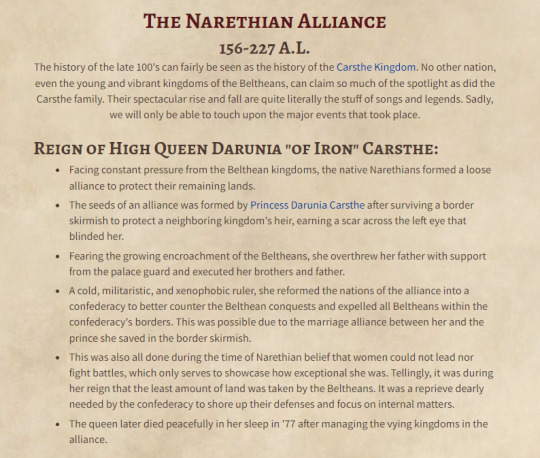

59 notes
·
View notes
Text
Origins of the Pibo: Let’s take a trip along the Silk Road.
1. Introduction to the garment:
Pibo 披帛 refers to a very thin and long shawl worn by women in ancient East Asia approximately between the 5th to 13th centuries CE. Pibo is a modern name and its historical counterpart was pei 帔. But I’ll use pibo as to not confuse it with Ming dynasty’s xiapei 霞帔 and a much shorter shawl worn in ancient times also called pei.
Below is a ceramic representation of the popular pibo.
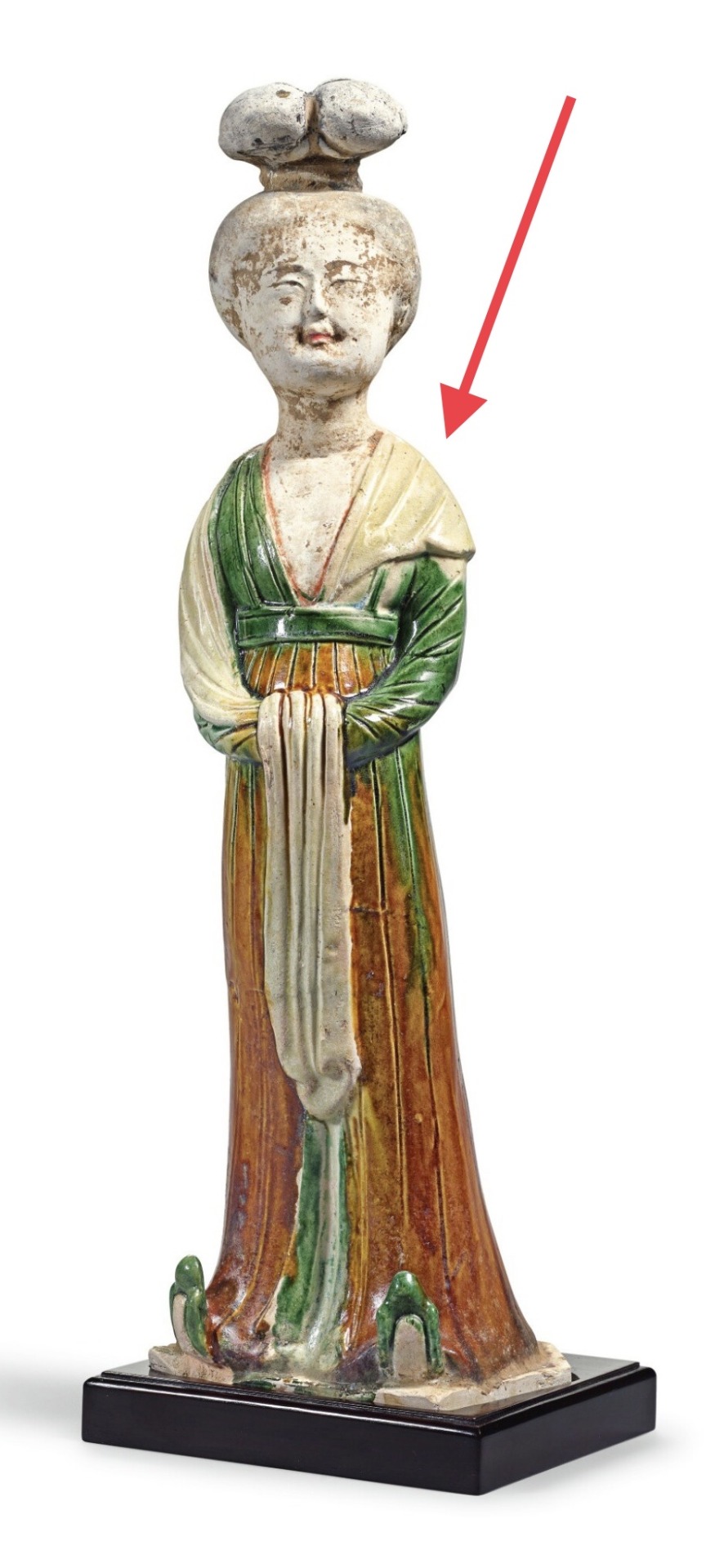
A sancai-glazed figure of a court lady, Tang Dynasty (618–690, 705–907 CE) from the Sze Yuan Tang Collection. Artist unknown. Sotheby’s [image source].
Although some internet sources claim that pibo in China can be traced as far back as the Qin (221-206 BCE) or Han (202 BCE–9 CE; 25–220 CE) dynasties, we don’t start seeing it be depicted as we know it today until the Northern and Southern dynasties period (420-589 CE). This has led to scholars placing pibo’s introduction to East Asia until after Buddhism was introduced in China. Despite the earliest art representations of the long scarf-like shawl coming from the Northern and Southern Dynasties period, the pibo reached its popularity apex in the Tang Dynasty (618–690 CE: 705–907 CE).
Academic consensus: Introduction via the Silk Road.
The definitive academic consensus is that pibo evolved from the dajin 搭巾 (a long and thin scarf) worn by Buddhist icons introduced to China via the Silk Road from West Asia.
披帛是通过丝绸之路传入中国的西亚文化, 与中国服饰发展的内因相结合而流行开来的一种"时世妆" 的形式. 沿丝绸之路所发现的披帛, 反映了丝绸贸易的活跃.
[Trans] Pibo (a long piece of cloth covering the back of the shoulders) was a popular female fashion period accessory introduced to China by West Asian cultures by way of the Silk Road and the development of Chinese costumes. The brocade scarves found along the Silk Road reflect the prosperity of the silk trade that flourished in China's past (Lu & Xu, 2015).
I want to add to the above theory my own speculation that, what the Chinese considered to be dajin, was most likely an ancient Indian garment called uttariya उत्तरीय.
2. Personal conjecture: Uttariya as a tentative origin to pibo.
In India, since Vedic times (1500-500 BCE), we see mentions in records describing women and men wearing a thin scarf-like garment called “uttariya”. It is a precursor of the now famous sari. Although the most famous depiction of uttariya is when it is wrapped around the left arm in a loop, we do have other representations where it is draped over the shoulders and cubital area (reverse of the elbow).
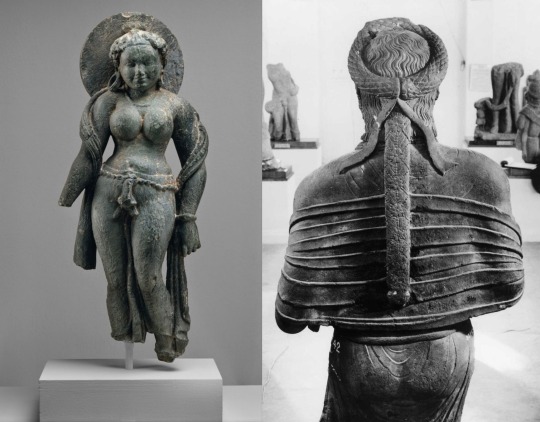
Left: Hindu sculpture “Mother Goddess (Matrika)”, mid 6th century CE, gray schist. Artist unknown. Looted from Rajasthan (Tanesara), India. Photo credit to Metropolitan Museum of Art, New York, United States [image source].
Right: Rear view of female statue possibly representing Kambojika, the Chief Queen of Mahakshatrapa Rajula, ca. 1st century CE. Artist unknown. Found in the Saptarishi Mound, Mathura, India. Government Museum, Mathura [image source].
Buddhism takes many elements from Hindu mythology, including apsaras अप्सरा (water nymphs) and gandharvas गन्धर्व (celestial musicians). The former was translated as feitian 飞天 in China. Hindu deities were depicted wearing clothes similar to what Indian people wore, among which we find uttariya, often portrayed in carvings and sculptures of flying and dancing apsaras or gods to show dynamic movement. Nevertheless, uttariya long predated Buddhism and Hinduism.
Below are carved representation of Indian apsaras and gandharvas. Notice how the uttariya are used.

Upper left: Carved relief of flying celestials (Apsara and Gandharva) in the Chalukyan style, 7th century CE, Chalukyan Dynasty (543-753 CE). Artist Unknown. Aihole, Karnataka, India. National Museum, New Delhi, India [image source]. The Chalukyan art style was very influential in early Chinese Buddhist art.
Upper right: Carved relief of flying celestials (gandharvas) from the 10th to the 12th centuries CE. Artist unknown. Karnataka, India. National Museum, New Delhi, India [image source].
Bottom: A Viyadhara (wisdom-holder; demi-god) couple, ca. 525 CE. Artist unknown. Photo taken by Nomu420 on May 10, 2014. Sondani, Mandsaur, India [image source].
Below are some of the earliest representations of flying apsaras found in the Mogao Caves, Gansu Province, China. An important pilgrimage site along the Silk Road where East and West met.
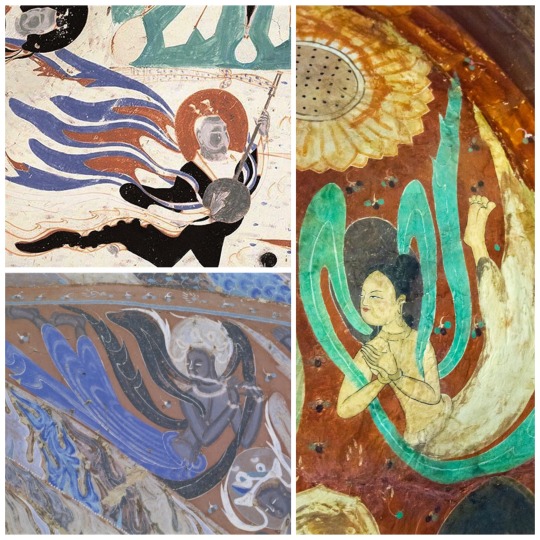
Left to right: Cave No. 461, detail of mural in the roof of the cave depicting either a flying apsara or a celestial musician. Western Wei dynasty (535–556 CE). Artist unknown. Mogao Grottoes, Dunhuang, China [image source].
Cave 285 flying apsara (feitian) in one of the Mogao Caves. Western Wei Dynasty (535–556 CE), Artist unknown. Photo taken by Keren Su for Getty Images. Mogao Grottoes, Dunhuang, China [image source].
Cave 249. Mural painting of feitian playing a flute, Western Wei Dynasty (535-556 CE). Image courtesy by Wang Kefen from The Complete Collection of Dunhuang Grottoes, Vol. 17, Paintings of Dance, The Commercial Press, Hong Kong, 2001, p. 15. Mogao Grottoes, Dunhuang, China [image source].
I theorize that it is likely that the pibo was introduced to China via Buddhism and Buddhist iconography that depicted apsaras (feitian) and other deites wearing uttariya and translated it to dajin.
3. Trickle down fashion: Buddhism’s journey to the East.
However, since Buddhism and its Indian-based fashion spread to West Asia first, to Sassanian Persians and Sogdians, it is likely that, by the time it reached the Han Chinese in the first century CE, it came with Persian and Sogdian influence. Persians’ fashion during the Sassanian Empire (224–651 CE) was influenced by Greeks (hellenization) who also had a a thin long scarf-like garment called an epliblema ἐπίβλημα, often depicted in amphora (vases) of Greek theater scenes and sculptures of deities.

Left to right: Dame Baillehache from Attica, Greece. 3rd century BCE, Hellenistic period (323-30 BCE), terracotta statuette. Photo taken by Hervé Lewandowski. Louvre Museum, Paris, France [image source].
Deatail view of amphora depicting the goddess Artemis by Athenian vase painter, Andokides, ca. 525 BCE, terracotta. Found in Vulci, Italy. Altes Museum, Berlin, Germany [image source].
Statue of a Kore (young girl), ca. 570 BCE, Archaic Period (700-480 BCE), marble. Artist unknown. Uncovered from Attica, Greece. Acropolis Museum, Athens, Greece [image source].
Detail view of Panathenaic (Olympic Games) prize amphora with lid, 363–362 BCE, Attributed to the Painter of the Wedding Procession and signed by Nikodemos, terracotta. Uncovered from Athens, Greece. J. Paul Getty Museum, Los Angeles, California, United States [image source].
Roman statue depicting Euterpe, muse of lyric poetry and music, ca. 2nd century CE, marble, Artist unknown. From the Villa of G. Cassius Longinus near Tivoli, Italy. Photo taken by Egisto Sani on March 12, 2012, Vatican Museums, Rome, Italy [image source].
Greek (or Italic) tomb mural painting from the Tomb of the Diver, ca. 470 BCE, fresco. Artist unknown. Photo taken by Floriano Rescigno. Necropolis of Paestum, Italy [image source].
Below are Iranian and Iraqi period representations of this long thin scarf.

Left to right: Closeup of ewer likely depicting a female dancer from the Sasanian Period (224–651 CE) in ancient Persia , Iran, 6th-7th century CE, silver and gilt. Artist unknown. Mary Harrsch. July 10, 2015. Arthur M. Sackler Gallery of Asian Art, Smithsonian, Washington D.C [image source].
Ewer with nude dancer probably representing a maenad, companion of Dionysus from the Sasanian Period (224–651 CE) in ancient Persia, Iran, 6th-7th century CE, silver and gilt. Artist unknown. Mary Harrsch. July 16, 2015. Arthur M. Sackler Gallery of Asian Art, Smithsonian, Washington D.C [image source].
Painting reconstructing the image of unveiled female dancers depicted in a fresco, Early Abbasid period (750-1258 CE), about 836-839 CE from Jawsaq al-Khaqani, Samarra, Iraq. Museum of Turkish and Islamic Art, Istanbul [image source].
The earliest depictions of Buddha in China, were very similar to West Asian depictions. Ever wonder why Buddha wears a long draped robe similar to a Greek himation (Romans called it toga)?
Take a look below at how much the Greeks influenced the Kushans in their art and fashion. The top left image is one of the earliest depictions of Buddha in China. Note the similarities between it and the Gandhara Buddha on the right.
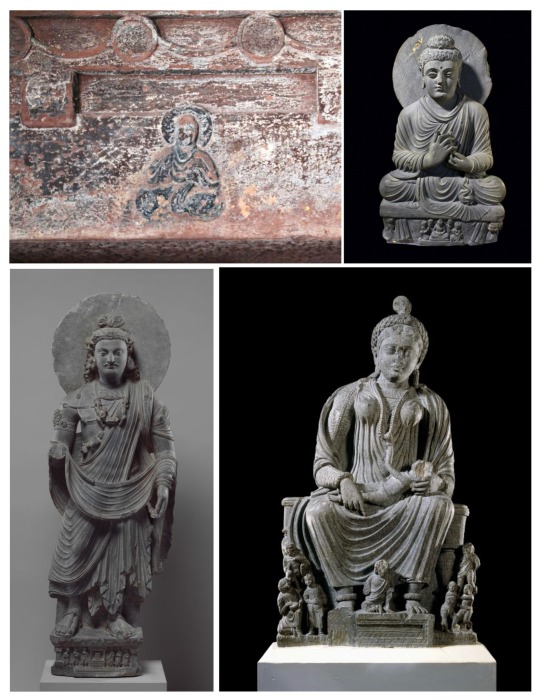
Left: Seated Buddha, Mahao Cliff Tomb, Sichuan Province, Eastern Han Dynasty, late 2nd century C.E. (photo: Gary Todd, CC0).
Right: Seated Buddha from Gandhara, Pakistan c. 2nd–3rd century C.E., Gandhara, schist (© Trustees of the British Museum)
Standing Bodhisattva Maitreya (Buddha of the Future), ca. 3rd century, gray schist. From Gandhara, Pakistan. Image credit to The Metropolitan Museum of Art, New York City, United States [image source].
Statue of seated goddess Hariti with children, ca. 2nd to 3rd centuries CE, schist. Artist unknown. From Gandhara, Pakistan. The British Museum, London, England [image source].
Before Buddhism spread outside of Northern India (birthplace), Indians never portrayed Buddha in human form.
Early Buddhist art is aniconic, meaning the Buddha is not represented in human form. Instead, Buddha is represented using symbols, such as the Bodhi tree (where he attained enlightenment), a wheel (symbolic of Dharma or the Wheel of Law), and a parasol (symbolic of the Buddha’s royal background), just to name a few. […] One of the earliest images [of Buddha in China] is a carving of a seated Buddha wearing a Gandharan-style robe discovered in a tomb dated to the late 2nd century C.E. (Eastern Han) in Sichuan province. Ancient Gandhara (located in present-day Afghanistan, Pakistan, and northwest India) was a major center for the production of Buddhist sculpture under Kushan patronage. The Kushans occupied portions of present-day Afghanistan, Pakistan, and North India from the 1st through the 3rd centuries and were the first to depict the Buddha in human form. Gandharan sculpture combined local Greco-Roman styles with Indian and steppe influences (Chaffin, 2022).
In the Mogao Caves, which contain some of the earliest Buddhist mural paintings in China, we see how initial Chinese Buddhist art depicted Indian fashion as opposed to the later hanfu-inspired garments.

Left to right: Cave 285, detail of wall painting, Western Wei dynasty (535–556 CE). Mogao Grottoes, Dunhuang, China. Courtesy the Dunhuang Academy [image source]. Note the clothes the man is wearing. It looks very similar to a lungi (a long men’s skirt).
Photo of Indian man sitting next to closed store wearing shirt, scarf, lungi and slippers. Paul Prescott. February 20, 2015. Varanasi, India [image source].
Cave 285, mural depiction of worshipping bodhisattvas, 6th century CE, Wei Dynasty (535-556 A.D.), Unknown artist. Mogao Grottoes, Dunhuang, China. Notice the half bow on his hips. That is a common style of tying patka (also known as pataka; cloth sashes) that we see throughout Indian history. Many of early Chinese Buddhist paintings feature it, including the ones at Mogao Caves.
Indian relief of Ashoka wearing dhoti and patka, ca. 1st century BC, Unknown artist. From the Amaravathi village, Guntur district, Andhra Pradesh, India. Currently at the Guimet Museum, Paris [image source].
Cave 263. Mural showing underlying painting, Northern Wei Dynasty (386–535 CE). Artist Unknown. Picture taken November 29, 2011, Mogao Grottoes, Dunhuang, China [image source]. Note the pants that look to be dhoti.
Comparison photo of modern dhoti advertisement from Etsy [image source].
Spread of Buddhism to East Asia.

Map depicting the spread of Buddhism from Northern India to the rest of Asia. Gunawan Kartapranata. January 31, 2014 [image source]. Note how Mahayana Buddhism arrived to China after passing through Kushan, Bactrean, and nomadic steppe lands, absorbing elements of each culture along the way.
Wealthy Buddhist female patrons emulated the fantasy fashion worn by apsaras, specifically, the uttariya/dajin and adopted it as an everyday component of their fashion.

Cave 285. feitian mural painting on the west wall, Western Wei Dynasty (535–556 CE). Artist unknown. Mogao Grottoes, Dunhuang, China [image source].
Cave 285. Detail view of offering bodhisattvas (bodhisattvas making offers to Buddha) next to the phoenix chariot on the Western wall of the cave. Western Wei Dynasty (535–556 CE). Artist unknown. Mogao Grottoes, Dunhuang, China [image source].
Cave 61 Khotanese (from the kingdom of Khotan 于阗 [56–1006 CE]) donor ladies, ca. 10th century CE, Five Dynasties period (907 to 979 CE). Artist unknown. Picture scanned from Zhang Weiwen’s Les oeuvres remarquables de l'art de Dunhuang, 2007, p. 128. Uploaded to Wikimedia Commons on October 11, 2012 by Ismoon. Mogao Grottoes, Dunhuang, China [image source].
Detail view of Ladies Adorning Their Hair with Flowers 簪花仕女图, late 8th to early 9th century CE, handscroll, ink and color on silk, Zhou Fang 周昉 (730-800 AD). Liaoning Provincial Museum, Shenyang, China [image source].
Therefore, the theory I propose of how the pibo entered East Asia is:
India —> Greek influenced West Asia (Sassanian Persians, Sogdians, Kushans, etc…) —> Han China —> Rest of East Asia (Three Kingdoms Korea, Asuka Japan, etc…)
Thus, the most likely theory, in my person opinion, is Buddhist iconography depicting uttariya encountered Greek-influenced West Asian Persian, Sogdian, and Kushan shawls, which combined arrived to China but wouldn’t become commonplace there until the explosion in popularity of Buddhism from the periods of Northern and Southern Dynasties to Song.
References:
盧秀文; 徐會貞. 《披帛與絲路文化交流》 [The brocade scarf and the cultural exchanges along the Silk Road]. 敦煌研究 (中國: 敦煌研究編輯部). 2015-06: 22 – 29. ISSN 1000-4106.
#hanfu#chinese culture#chinese history#buddhism#persian#sogdian#kushan#gandhara#indian fashion#uttariya#pibo#history#asian culture#asian art#asian history#asian fashion#east asia#south asia#india#pakistan#iraq#afghanistan#sassanian#silk road#fashion history#tang dynasty#eastern han dynasty#cultural exchange#greek fashion#mogao caves
283 notes
·
View notes
Text


This is a message to my black brothers and sisters
Learn about your history
Ethiopia is one of the oldest countries in Africa; the emergence of Ethiopian civilization dates back thousands of years. Abyssinia or rather "Ze Etiyopia" was ruled by the Semitic Abyssinians (Habesha) composed mainly of the Amhara and Tigray, the Cushitic Agaw. In the Eastern escarpment of the Ethiopian highlands and more so the lowlands was the home of the Arab-descended Harari that founded Sultanates such as Ifat and Adal and the Afars. In the central and south were found the ancient Sidama and Semitic Gurage, among otheres. One of the first kingdoms to rise to power in the territory was the kingdom of D'mt in the 10th century BC, which established its capital at Yeha. In the first century AD the Aksumite Kingdom rose to power in the modern Tigray Region with its capital at Aksum and grew into a major power on the Red Sea, subjugating South Arabia and Meroe and its surrounding areas. In the early fourth century, during the reign of Ezana, Christianity was declared the state religion. Ezana's reign is also when the Aksumites first identified themselves as "Ethiopians", and not long after, Philostorgius became the first foreign author to call the Aksumites Ethiopians.[The Aksumite empire fell into decline with the rise of Islam in the Arabian peninsula, which slowly shifted trade away from the Christian Aksum.[citation needed] It eventually became isolated, its economy slumped and Aksum's commercial domination of the region ended.The Aksumites gave way to the Zagwe dynasty, who established a new capital at Lalibela before giving way to the Solomonic dynasty in the 13th century. During the early Solomonic period, Ethiopia went through military reforms and imperial expansion that allowed it to dominate the Horn of Africa.
How did Ethiopia Resist Imperialism?
Ethiopia, formerly Abyssinia, is one of the world’s oldest countries. Dating to around 400 BCE, the region is documented in the in the King James Version of the Bible as the Kingdom of Axum. Along with Rome, Persia, and China, Axum was considered one of the four great powers of the era. Throughout the millennia of its history, the willingness of the country’s people—from farmers to kings—to come together as one, coupled with its geographic isolation and economic prosperity, helped Ethiopia score decisive victories against a series of global colonialist forces.
Ethiopia is considered “never colonized” by some scholars, despite Italy's occupation from 1936–1941 because it did not result in a lasting colonial administration.
Seeking to expand its already considerable colonial empire in Africa, Italy invaded Ethiopia in 1895. In the ensuing First Italo-Ethiopian War (1895-1896), Ethiopian troops won a crushing victory over Italian forces at the Battle of Adwa on March 1, 1896. On October 23, 1896, Italy agreed to the Treaty of Addis Ababa, ending the war and recognizing Ethiopia as an independent state.
On Oct. 3, 1935, Italian dictator Benito Mussolini, hoping to rebuild his nation’s prestige lost in the Battle of Adwa, ordered a second invasion of Ethiopia. On May 9, 1936, Italy succeeded in annexing Ethiopia. On June 1 of that year, the country was merged with Eritrea and Italian Somalia to form Africa Orientale Italiana (AOI or Italian East Africa).
Ethiopian Emperor Haile Selassie made an impassioned appeal for assistance in removing the Italians and re-establishing independence to the League of Nations on June 30, 1936, gaining support from the U.S. and Russia. But many League of Nations members, including Britain and France, recognized Italian colonization.
It was not until May 5, 1941, when Selassie was restored to the Ethiopian throne, that independence was regained.
Ethiopia's ability to resist being swept up in the "Scramble for Africa" can be credited to the stability of its longstanding imperial government, beginning with the Abyssinian Empire in the 13th century, and lasting into the late 20th century, with the exception of a brief Italian occupation during the 1930s. King Menelik II, the Emperor during the period of rampant European exploration and colonization in Africa, was careful to cultivate an alliance with the smaller surrounding kingdoms of North Africa, and with European powers including Italy and Russia. When Italy began to turn the sights of their imperial ambitions toward Ethiopia, the Ethiopian military became the only African kingdom able to successfully resist the military might of European colonial power, using Russian-supplied weapons to defeat the Italian invading force at the Battle of Adwa in 1896. In the aftermath of the battle, in exchange for permanent recognition as an independent empire, Menelik II granted Italy the right to claim the neighboring territory of Eritrea under their imperial umbrella.
Ethiopians have a history of taming lions.
Many Emperors kept pet lions including Halie Selassie. Occasionally visitors like Kwame Nkrumah could pet one of the lions!
This practice of keeping lions is said to date back thousands of years to the Axumite period.The descendants of the Royal Lions currently live in the Addis Ababa zoo.
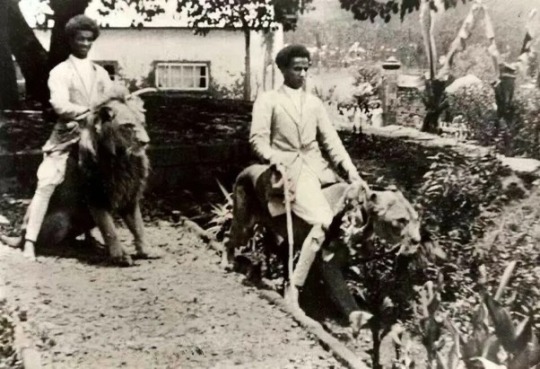
Meet his imperial majesty, the King of the Jungle.
And if, with his thick, shaggy mane Challa seems to have something of a frisky regal air about him - it's because he knows that he is a genuine blue blood.Challa is a direct descendant of Mochuria and Mollua - royal lions, which the late Emperor Haile Selassie kept as pets. The Emperor's practice of keeping pet lions is said to date thousands of years back to the Axumite period.Years ago in Ethiopia, Lions were pets to the people, some were used like donkeys, some like dogs kept at home. Emperor Haile Selassie of Ethiopia had lions he kept as pets, while some Ethiopians could even ride on them. These were not wild lions, they grew up with humans and became domesticated.They didn't go after human blood or other animals, lions roamed around the streets of Ethiopia and live was beautiful with them. Ethiopia is in East Africa, it's a rugged, landlocked country split by the Great Rift Valley, Ethiopia is a place of ancient culture, they believe and still hold on to ancient affairs.
Any lion that goes wild was immediately hunted killed, they were only killed if they kill a human and not animals like goats and chickens. They forbid killing and eating of any lion because lions were pets used in different palaces.
Ethiopia as a country had its origin in about 980 B.C., which makes it one of the oldest nations in the world.
Due to this very long history and an unmatched diversity of people and cultures, the country has often been described as a “museum of peoples”. With such a highly diverse population, Ethiopia houses an intricate tapestry of language and ethnic groups.
Also nicknamed the “Land of 13 Sunshine’s”, Ethiopia is often described as one of the most enthralling and enchanting places in the world – and definitely in Africa.
Ethiopia may not be the first place any traveller think of when planning or booking a next holiday, but it may just as well soon be the case. As African country Ethiopia can boast about having been at peace for at least the previous 15 years or more years and its economy is consequently one of the fastest growing in the world.
With the added bonus of an astounding diversity of landscapes, mixture of cultures and history that tracks back to when homo sapiens first started to raise itself up onto two legs, a traveller suddenly may look forward to a surprising and breath-taking travel destination.
But talking about planning and holiday dated, you probably didn’t know that this unique nation even has its own calendar?
This is but one of a myriad fascinating facts about the country, of which a number are discussed in this article. Looking at the country’s ancient and statutory history, its religion, culture, people and natural phenomena, here are at least 44 random but fascinating facts that you can ponder in anticipation of a visit to this eastern African country in the near future:
Fact number 1 – The oldest people in the world probably lived here.
Fact number 2 – Ethiopia is the oldest independent country in Africa and the only African country that could evade colonial rule.
Fact number 3 – Ethiopia was one of the first African forces to achieve a significant victory over a European colonial power.
Fact number 4 – Ethiopia has a rich history of rulers, including emperors and queens.
Fact number 5 – Ethiopia is perceived to be the diplomatic capital of the African continent
Fact number 6 – Ethiopia is the country with the second highest population in Africa, and with almost 1,5 % of the world population.
Fact number 8 – Ethiopia has the most orphans in the world.
Fact number 10 – Addis Ababa is the highest capital city in Africa.
Fact number 11 – More than 200 dialects are spoken by the peoples of the country.
Please like and share so others can see, drop your comments below and let me know what you think.
98 notes
·
View notes